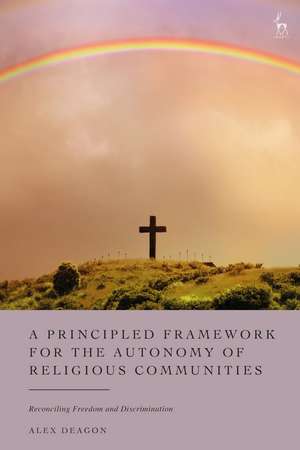A Principled Framework for the Autonomy of Religious Communities: Reconciling Freedom and Discrimination
Autor Alex Deagonen Limba Engleză Hardback – 22 feb 2023
| Toate formatele și edițiile | Preț | Express |
|---|---|---|
| Paperback (1) | 258.15 lei 3-5 săpt. | |
| Bloomsbury Publishing – 28 aug 2024 | 258.15 lei 3-5 săpt. | |
| Hardback (1) | 511.57 lei 6-8 săpt. | +110.73 lei 10-14 zile |
| Bloomsbury Publishing – 22 feb 2023 | 511.57 lei 6-8 săpt. | +110.73 lei 10-14 zile |
Preț: 511.57 lei
Preț vechi: 731.87 lei
-30% Nou
Puncte Express: 767
Preț estimativ în valută:
97.89€ • 102.48$ • 80.100£
97.89€ • 102.48$ • 80.100£
Carte tipărită la comandă
Livrare economică 05-19 aprilie
Livrare express 04-08 martie pentru 120.72 lei
Preluare comenzi: 021 569.72.76
Specificații
ISBN-13: 9781509950638
ISBN-10: 150995063X
Pagini: 280
Dimensiuni: 156 x 234 x 21 mm
Greutate: 0.57 kg
Editura: Bloomsbury Publishing
Colecția Hart Publishing
Locul publicării:London, United Kingdom
ISBN-10: 150995063X
Pagini: 280
Dimensiuni: 156 x 234 x 21 mm
Greutate: 0.57 kg
Editura: Bloomsbury Publishing
Colecția Hart Publishing
Locul publicării:London, United Kingdom
Caracteristici
Adopts the novel theoretical approach of peaceful coexistence, which is designed to cut through the apparent stalemate between religious freedom and equality advocates
Notă biografică
Alex Deagon is Senior Lecturer at the Faculty of Law, Queensland University of Technology, Australia.
Cuprins
PART IRELIGIOUS FREEDOM VERSUS ANTI-DISCRIMINATION?Introduction I. The Purpose of this Book: Reconciling Freedom and Discrimination II. Religious Freedom and Equality: A Tense Relationship III. Shortcomings in the Literature IV. Peaceful Coexistence, Shared Premises and Political Virtues V. Models of the Religion-State Relationship VI. Structure of the Book PART IILEGAL FRAMEWORKS1. Australia I. Introduction II. The Australian Constitution III. Commonwealth Legislation IV. Summary: The Legal Infrastructure for the Autonomy of Religious Communities in Australia V. Evaluation of the Law: Peaceful Coexistence and the Theological Virtues VI. Conclusion: The Autonomy of Religious Communities in Australian Law 2. United States I. Introduction II. The First Amendment of the US Constitution III. Federal Legislation IV. Summary: The Legal Infrastructure for the Autonomy of Religious Communities in the US V. Evaluation of the Law: Peaceful Coexistence and the Theological Virtues VI. Conclusion: The Autonomy of Religious Communities in US Law 3. England I. Introduction II. European Convention of Human Rights III. UK Legislation IV. Summary: The Legal Infrastructure for the Autonomy of Religious Communities in England V. Evaluation of the Law: Peaceful Coexistence and the Theological Virtues VI. Conclusion: The Autonomy of Religious Communities in English Law PART IIITHEORETICAL FRAMEWORKS4. Australia: Pragmatic Pluralism or Mild Establishment? I. Introduction II. Australia as Pragmatically Pluralist III. Evaluation of Australia's Pragmatic Pluralism IV. Proposing an Alternative: Mild Establishment? V. Implications for Australia's Legal Framework VI. Conclusion 5. United States: Secularism or Pluralism? I. Introduction II. United States as Secular Separationist III. Evaluation of Secular Separationism in the US IV. Proposing an Alternative: Pluralism V. Implications for the United States Legal Framework VI. Conclusion 6. England: Substantive Establishment?I. Introduction II. Elements of English Establishment III. Nature of English Establishment: Substantive (Theological) or Formal (Secular)? IV. Peaceful Coexistence and an Evaluation of English Establishment V. Implications for the English Legal Framework VI. Conclusion PART IVA PRINCIPLED FRAMEWORK7. Reconciling Religious Freedom and Equality in a Principled Framework I. Introduction II. Reconciling Religious Freedom and Equality III. Recommendations
